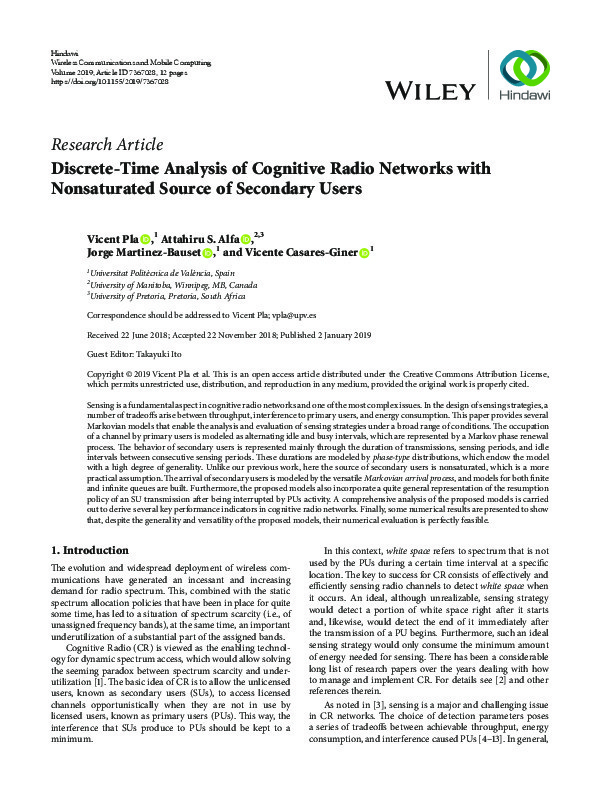JavaScript is disabled for your browser. Some features of this site may not work without it.
Buscar en RiuNet
Listar
Mi cuenta
Estadísticas
Ayuda RiuNet
Admin. UPV
Discrete Time Analysis of Cognitive Radio Networks with Non-Saturated Source of Secondary Users
Mostrar el registro sencillo del ítem
Ficheros en el ítem
| dc.contributor.author | Pla, Vicent
|
es_ES |
| dc.contributor.author | Alfa, Attahiru S.
|
es_ES |
| dc.contributor.author | Martínez Bauset, Jorge
|
es_ES |
| dc.contributor.author | Casares-Giner, Vicente
|
es_ES |
| dc.date.accessioned | 2021-01-09T04:31:56Z | |
| dc.date.available | 2021-01-09T04:31:56Z | |
| dc.date.issued | 2019-01-02 | es_ES |
| dc.identifier.uri | http://hdl.handle.net/10251/158498 | |
| dc.description.sponsorship | The research of V. Pla was partially supported by the Ministry of Education of Spain under Grant PR2011-0055. The research of A. S. Alfa was partially supported by the NRF SARChI Chair in ASN cohosted by UP and CSIR | es_ES |
| dc.language | Inglés | es_ES |
| dc.publisher | John Wiley & Sons | es_ES |
| dc.relation.ispartof | Wireless Communications and Mobile Computing (Online) | es_ES |
| dc.rights | Reconocimiento (by) | es_ES |
| dc.subject.classification | INGENIERIA TELEMATICA | es_ES |
| dc.title | Discrete Time Analysis of Cognitive Radio Networks with Non-Saturated Source of Secondary Users | es_ES |
| dc.type | Artículo | es_ES |
| dc.identifier.doi | 10.1155/2019/7367028 | es_ES |
| dc.relation.projectID | info:eu-repo/grantAgreement/ME//PR2011-0055/ES/PR2011-0055/ | |
| dc.rights.accessRights | Abierto | es_ES |
| dc.contributor.affiliation | Universitat Politècnica de València. Departamento de Comunicaciones - Departament de Comunicacions | es_ES |
| dc.description.bibliographicCitation | Pla, V.; Alfa, AS.; Martínez Bauset, J.; Casares-Giner, V. (2019). Discrete Time Analysis of Cognitive Radio Networks with Non-Saturated Source of Secondary Users. Wireless Communications and Mobile Computing (Online). 1-12. https://doi.org/10.1155/2019/7367028 | es_ES |
| dc.description.accrualMethod | S | es_ES |
| dc.relation.publisherversion | https://doi.org/10.1155/2019/7367028 | es_ES |
| dc.description.upvformatpinicio | 1 | es_ES |
| dc.description.upvformatpfin | 12 | es_ES |
| dc.type.version | info:eu-repo/semantics/publishedVersion | es_ES |
| dc.identifier.eissn | 1530-8677 | es_ES |
| dc.relation.pasarela | S\375164 | es_ES |
| dc.contributor.funder | Ministerio de Educación | |
| dc.description.references | Zhang, J., Zheng, F.-C., Gao, X.-Q., & Zhu, H.-B. (2015). Which Is Better for Opportunistic Spectrum Access: The Duration-Fixed or Duration-Variable MAC Frame? IEEE Transactions on Vehicular Technology, 64(1), 198-208. doi:10.1109/tvt.2014.2318512 | es_ES |
| dc.description.references | Pradhan, H., Kalamkar, S. S., & Banerjee, A. (2015). Sensing-Throughput Tradeoff in Cognitive Radio With Random Arrivals and Departures of Multiple Primary Users. IEEE Communications Letters, 19(3), 415-418. doi:10.1109/lcomm.2015.2393305 | es_ES |
| dc.description.references | Huang, L.-F., Zhou, S.-L., Guo, D., & Chao, H.-C. (2013). MHC-MAC: Cognitive MAC with asynchronous-assembly line mode for improving spectrum utilization and network capacity. Mathematical and Computer Modelling, 57(11-12), 2742-2749. doi:10.1016/j.mcm.2011.11.074 | es_ES |
| dc.description.references | Wang, S., Wang, Y., Coon, J. P., & Doufexi, A. (2012). Energy-Efficient Spectrum Sensing and Access for Cognitive Radio Networks. IEEE Transactions on Vehicular Technology, 61(2), 906-912. doi:10.1109/tvt.2011.2180549 | es_ES |
| dc.description.references | Tang, L., Chen, Y., Hines, E. L., & Alouini, M.-S. (2011). Effect of Primary User Traffic on Sensing-Throughput Tradeoff for Cognitive Radios. IEEE Transactions on Wireless Communications, 10(4), 1063-1068. doi:10.1109/twc.2011.020111.101870 | es_ES |
| dc.description.references | Yuan Wu, & Tsang, D. H. K. (2011). Energy-Efficient Spectrum Sensing and Transmission for Cognitive Radio System. IEEE Communications Letters, 15(5), 545-547. doi:10.1109/lcomm.2011.032811.110102 | es_ES |
| dc.description.references | Wu, Y., Lau, V. K. N., Tsang, D. H. K., & Qian, L. P. (2012). Energy-Efficient Delay-Constrained Transmission and Sensing for Cognitive Radio Systems. IEEE Transactions on Vehicular Technology, 61(7), 3100-3113. doi:10.1109/tvt.2012.2198506 | es_ES |
| dc.description.references | Hoang, A. T., Liang, Y.-C., Wong, D. T. C., Zeng, Y., & Zhang, R. (2009). Opportunistic spectrum access for energy-constrained cognitive radios. IEEE Transactions on Wireless Communications, 8(3), 1206-1211. doi:10.1109/twc.2009.080763 | es_ES |
| dc.description.references | Chang, N. B., & Mingyan Liu. (2009). Optimal Channel Probing and Transmission Scheduling for Opportunistic Spectrum Access. IEEE/ACM Transactions on Networking, 17(6), 1805-1818. doi:10.1109/tnet.2009.2014460 | es_ES |
| dc.description.references | Wellens, M., Riihijärvi, J., & Mähönen, P. (2009). Empirical time and frequency domain models of spectrum use. Physical Communication, 2(1-2), 10-32. doi:10.1016/j.phycom.2009.03.001 | es_ES |
| dc.description.references | Alfa, A. S. (2016). Applied Discrete-Time Queues. doi:10.1007/978-1-4939-3420-1 | es_ES |
| dc.description.references | Bae, Y. H., Alfa, A. S., & Choi, B. D. (2011). Analysis of a contention-based opportunistic spectrum access under general channel activity model. Performance Evaluation, 68(3), 271-289. doi:10.1016/j.peva.2010.12.003 | es_ES |
| dc.description.references | Robert, S., & Le Boudec, J.-Y. (1997). New models for pseudo self-similar traffic. Performance Evaluation, 30(1-2), 57-68. doi:10.1016/s0166-5316(96)00055-7 | es_ES |








